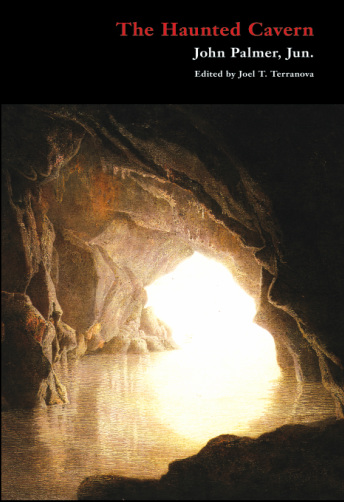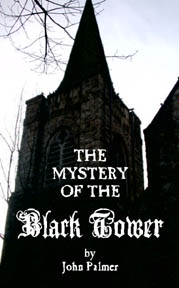
The Haunted Cavern (1795)
John Palmer, Jun, Edited by Joel T. Terranova
Book Description
Young Eldred wants nothing more than to marry his beloved Jane. But Jane’s father, the cruel Sir James Wallace, has other plans, intending to wed her to the fierce chieftain Donald instead. Donald, jealous of his rival, has Eldred seized and imprisoned in the dungeons of a haunted cavern, where a skeleton, a rusty dagger, and a mouldering manuscript will uncover long-hidden, deadly secrets and reveal the mysterious fate of Eldred’s father, Lord Glencairn!
The Haunted Cavern (1795) was the first novel by John Palmer, Jun. (1776-1809), who published it at age nineteen. A “tale of shrieking spectres and bloody murders” (The Critical Review) featuring “gloomy caverns, dismal dungeons, ghastly skeletons, pale ghosts, fierce combats, [and] horrid murders” (The Analytical Review), Palmer’s novel is an entertaining example of the type of Gothic fiction that flourished in the wake of Ann Radcliffe’s The Mysteries of Udolpho (1794). This new edition, the first in almost two centuries, includes a new introduction by Joel T. Terranova, seven contemporary reviews of the novel, a facsimile of the original title page, and a reproduction of the frontispiece from the scarce New York edition of 1796.
John Palmer, Jun, Edited by Joel T. Terranova
Book Description
Young Eldred wants nothing more than to marry his beloved Jane. But Jane’s father, the cruel Sir James Wallace, has other plans, intending to wed her to the fierce chieftain Donald instead. Donald, jealous of his rival, has Eldred seized and imprisoned in the dungeons of a haunted cavern, where a skeleton, a rusty dagger, and a mouldering manuscript will uncover long-hidden, deadly secrets and reveal the mysterious fate of Eldred’s father, Lord Glencairn!
The Haunted Cavern (1795) was the first novel by John Palmer, Jun. (1776-1809), who published it at age nineteen. A “tale of shrieking spectres and bloody murders” (The Critical Review) featuring “gloomy caverns, dismal dungeons, ghastly skeletons, pale ghosts, fierce combats, [and] horrid murders” (The Analytical Review), Palmer’s novel is an entertaining example of the type of Gothic fiction that flourished in the wake of Ann Radcliffe’s The Mysteries of Udolpho (1794). This new edition, the first in almost two centuries, includes a new introduction by Joel T. Terranova, seven contemporary reviews of the novel, a facsimile of the original title page, and a reproduction of the frontispiece from the scarce New York edition of 1796.
|
BOOK DETAILS
Hardcover with dust jacket ISBN-13: 978-1939140623 List Price: $39.99 U.S. Pages: 126 Published: 2013 |
|
BOOK DETAILS
Trade paper
ISBN-13: 978-1939140630
List Price: $16.99 U.S.
Pages: 126
Published: 2013
Trade paper
ISBN-13: 978-1939140630
List Price: $16.99 U.S.
Pages: 126
Published: 2013
MORE TITLES BY THIS AUTHOR
AUTHOR BIOGRAPHY
John Palmer, Jun. was born in 1776, one of eight children of John Palmer (1744-1798), a celebrated stage actor. The younger Palmer’s life was difficult: his mother died young, and his father—who was known as a rather dissolute and untrustworthy character, nicknamed “Plausible Jack”—had difficulty supporting his large family. The older Palmer famously died on stage in 1798 while acting in Kotzebue’s The Stranger, speaking the line “There is another and a better world” before dropping down dead.
Following in his father’s footsteps, John Palmer, Jun. made his acting debut on June 20, 1791, playing Prince Hal to his father’s Falstaff in Henry IV, Part One. Later, he supplemented his income by writing. His first novel, The Haunted Cavern, appeared in December 1795, was widely reviewed, and apparently sold well, or at least well enough to be reprinted in Dublin, New York, and Baltimore the following year. Palmer’s second effort, The Mystery of the Black Tower (1796), was printed by William Lane’s Minerva Press and was sold by subscription. Other novels followed: The World as it Goes; or, Portraits from Nature (1803) and The Mystic Sepulchre; or, Such Things Have Been (1806).
Palmer died at Plymouth Dock of a fever on March 27, 1809, aged 33. His final novel, Like Master Like Man, was published posthumously for the benefit of Palmer’s widow in 1811, with a preface by George Colman, the Younger. In his preface, Colman paints a somewhat tragic picture of Palmer: “The tenderest mutual affection, between husband and wife, urged him to struggle hard against poverty, upon emergencies:—he travell’d from minor town to town, after managers who would engage him; he wrote novels for booksellers who would purchase, or advance a few guineas upon them, in his need;—latterly, he labour’d to exist, more, I think, on account of her he loved than for himself; and, in tugging for life, the thread snapp’d:—I have every reason to believe he died of a broken heart.”
Following in his father’s footsteps, John Palmer, Jun. made his acting debut on June 20, 1791, playing Prince Hal to his father’s Falstaff in Henry IV, Part One. Later, he supplemented his income by writing. His first novel, The Haunted Cavern, appeared in December 1795, was widely reviewed, and apparently sold well, or at least well enough to be reprinted in Dublin, New York, and Baltimore the following year. Palmer’s second effort, The Mystery of the Black Tower (1796), was printed by William Lane’s Minerva Press and was sold by subscription. Other novels followed: The World as it Goes; or, Portraits from Nature (1803) and The Mystic Sepulchre; or, Such Things Have Been (1806).
Palmer died at Plymouth Dock of a fever on March 27, 1809, aged 33. His final novel, Like Master Like Man, was published posthumously for the benefit of Palmer’s widow in 1811, with a preface by George Colman, the Younger. In his preface, Colman paints a somewhat tragic picture of Palmer: “The tenderest mutual affection, between husband and wife, urged him to struggle hard against poverty, upon emergencies:—he travell’d from minor town to town, after managers who would engage him; he wrote novels for booksellers who would purchase, or advance a few guineas upon them, in his need;—latterly, he labour’d to exist, more, I think, on account of her he loved than for himself; and, in tugging for life, the thread snapp’d:—I have every reason to believe he died of a broken heart.”

